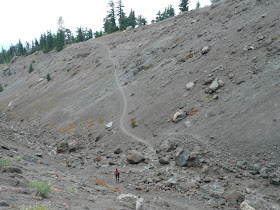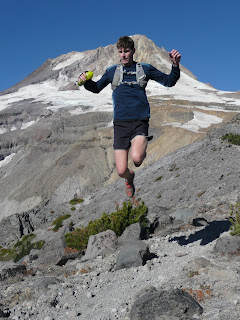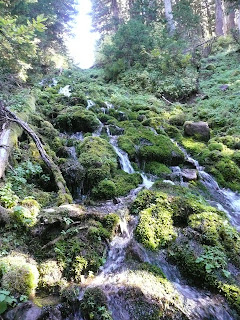Rocky Raccoon has one of the fastest trail 100-mile courses and is made of five 20-mile loops in Huntsville State Park in Texas. So for anyone looking for a more manageable first 100-miler or a personal best, this course is ideal. Other similarly fast courses in the US include Umstead, Javelina, Long Haul, Keys Ultra and Rocky Road.
It's a race that went very well for me in 2011 when I set the course record and there were several important things I learnt before, during and after in terms of how to train for and race that type of course. So, given the race is just over three months away, I thought I'd share some tips and coaching advice that could be of help to those in training.
Also, I've already written posts about training for the Comrades Marathon, Western States 100 and the Marathon des Sables. And I'll include a post on the Swiss Alpine Marathon K78 in Davos at a later date.
Here are the key things to bear in mind in general when training for and racing RR100 and these apply to similarly non-mountainous 100s:
What's the race like?
- 100 miles in five identical loops over rolling trails with no big hills (supposedly around 5,375ft of elevation gain, although I've not seen a profile to back that figure up)
- The high point of the course is 370ft, so altitude is not an issue
- Mild temperatures which may be below freezing at the start but should be comfortable during the day, usually reaching 50-60F)
- Generally non-technical underfoot so if it's not wet and muddy, road shoes are probably fine
- Aid stations are never more than six miles apart and there's easy drop-bag access at the start/finish (visited six times) and DamNation aid station (visited ten times)
- 30 hour cut-off means this is an ideal first 100 since there are no mountains to destroy the legs so it's possible to have long walking sections and still easily beat the cut-off
- Different belt buckles for sub-24 hours and sub-30 hours
- Alligators in the lake you run next too, except you probably won't see them
 |
| A typical, easy section of the trail. Photo: Dave Carder |
- That depends on what your past ultra experience is and whether you're aiming for a finish or to knock out a personal best
- Either way, long runs will make the biggest difference to your endurance and ability to maintain a good pace in the last two laps, but there's a trade-off between the training benefits from the very long runs and the ability to recover from them and avoid injuries
- It's worth including a 50-mile race or training run in your build up for both mental and physical endurance
- The ideal way to get to know the terrain is to run the Rocky Raccoon 50-miler first then the 100-miler the following year, but this is certainly not essential
- Still include speed work - prioritize quality mileage over quantity given this has a very runnable course
- Road and trail marathons are perfect as long tempo runs if you race them at 90%+ effort so they don't wipe you out as much as an all-out effort and there's less chance of getting injured when taking it a little easier
- Back-to-back long road runs are excellent training but have to be weighed up against the time it takes to recover; two marathons on a weekend are particularly good and much less stress on the body than resorting to multiple single-day 50-milers
- Ideally include a lot of trail running in your training, both to get comfortable on trails and to build up strength and stability in your ankles plus your leg and core stabilizing muscles
- Strength training on the legs is more important than for marathons due to the distance and rolling hills, but make the exercises specific to running, not just about building up big leg muscles
- Practice running on trails in the dark with a head lamp since the race is during winter and there's less than 12 hours of light
 |
| The pre-dawn start line. Photo: Dave Carder |
- For an experienced ultrarunner who wants to go for a time on this course, don't do too many long, slow runs since the ability to keep up an efficient pace will make a big difference to your time
- Faster long runs, such as in practice races of 20 miles to 50k are ideal since anyone who has run sub-24 hours on a mountain ultra won't need to be on their feet for as long in this style of race, barely running in the dark during the night
- So don't get overly focused on how many miles per week you run and bear in mind that someone with years of ultras under their belt already has plenty of endurance so a greater focus on speed work is required than for other 100-milers - this type of race can be run well on relatively low mileage, but I wouldn't recommend less than 50 miles/week for an extended period if you want to turn up well-trained (I averaged around 60-65 miles/week in my build up for the course record but mainly focused on improving my marathoning as I knew I had a good level of endurance)
- Since your legs won't get as damaged on this flatter course, the weakest link on the day is more likely to be related to bonking badly from not taking in enough calories, so it's important to practice eating in your long runs
- Bad or inadequate nutrition will slow you dramatically so work out what you can stomach in advance then fuel early and often, before you get to a point where your stomach virtually shuts down and eating becomes hard or impossible
- Practice hydration in your training runs and try to get an idea of which sports' drinks you can stomach best, ideally trying out various brands to see how they work for you on long runs
- Hilly and trail-based training runs are ideal but you can just about get away with living in a big city and training only on roads and treadmills for this type of gentler course, which would be more of a disadvantage in more mountainous ultras
- Practice hard power-hiking as you will almost certainly walk sections of the race and the more you can improve and get more efficient at this, the less energy and effort it will take, thus allowing a degree of recovery during the race so you can get back to running well again
- The first 45 minutes are in the dark so have a plan of what to do with your head lamp after that point, especially if you need to use the same one that evening
- Like most ultras, people tend to go out too fast, so bear in mind that going even a little too hard early on is likely to cause a significant slow-down later on
- Make sure you have a general plan for your pacing but allow yourself to be guided by the perceived effort, which is something that needs to be refined through years of experience and training to know the appropriate effort level (not the appropriate pace) that is sustainable
- The main reason for a poor time is slowing down considerably later on, not going out too slowly
- Look through the course directions to get an idea of the route and where the aid stations are so you know what to expect - the fact the race is made of laps means you'll get very familiar with it
- Try not to spend too much time at the start/finish area at the end of each loop as this is the easiest place to drop and it's mentally better to get in and out quickly than to spend more time with drop bags etc. at DamNation, six miles later
- Plan ahead for any issues or problems that you're likely to face, like chaffing, batteries dying in your head lamp, bonking etc - it's easier to have a plan ready than to work out what to do when you're semi-delirious after hours of running
- Don't forget any vital pieces of gear, such as a rain jacket as a precaution - simple errors like this can lead to DNFs
- Pacers and crews can be helpful, especially for motivation, but this looped format means RR100 is about the easiest trail 100 miler to do unsupported so it's really a matter of preference and convenience (although my pacers, Paul and Meredith Terranova, did a great job in keeping me occupied and avoiding wasted time at aid stations)
- Don't get too focused on a time or buckle cut-off until very near the end - you'll run your best race and time by running by feel so that you're not adjusting pace constantly based on what your watch says
- The cut-offs are generous so even if things go horribly wrong there's probably enough time to rest and recuperate and still get back on the course with enough time to finish, so don't drop until you're timed out unless you're injured or seriously ill
- Beware the chair, like in any ultra - if you sit down, you'll find it a lot harder to get going again
- Finally, at the finish your recovery will be improved by eating anything (ideally protein and carbs) within the first 30 minutes as well as lying down for several minutes with your legs raised slightly above your heart so the blood doesn't pool in your legs






















































































